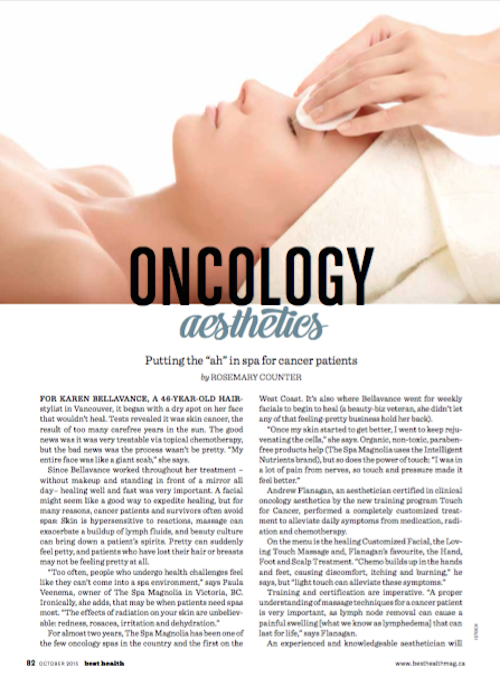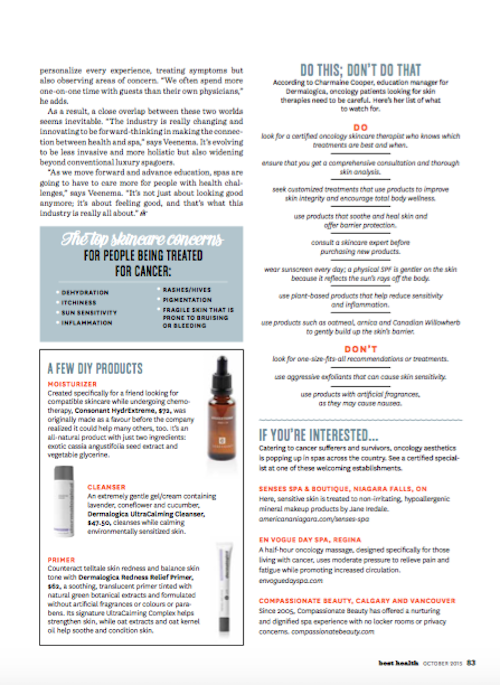Oncology Aesthetics
Putting the “ah” in spa for cancer patients
For Karen Bellavance, a 46-year-old hair stylist in Vancouver, it began with a dry spot on her face that wouldn’t heal. Tests revealed it was skin cancer, the result of too many carefree years in the sun. The good news was it was very treatable via topical chemotherapy, but the bad news was the process wasn’t be pretty. “My entire face was like a giant scab,” she says.
Since Bellavance worked throughout her treatment – without makeup and standing in front of a mirror all day – healing well and fast was very important. A facial might seem like a good way to expedite healing, but for many reasons, cancer patients and survivors often avoid spas: Skin is hypersensitive to reactions, massage can exacerbate a buildup of lymph fluids, and beauty culture can bring down a patient’s spirits. Pretty can suddenly feel petty, and patients who have lost their hair or breasts may not be feeling pretty at all.
“Too often, people who undergo health challenges feel like they can’t come into a spa environment,” says Paula Veenema, owner of The Spa Magnolia in Victoria, BC. Ironically, she adds, that may be when patients need spas most. “The effects of radiation on your skin are unbelievable: redness, rosacea, irritation and dehydration.”
For almost two years, The Spa Magnolia has been one of the few oncology spas in the country and the first on the West Coast. It’s also where Bellavance went for weekly facials to begin to heal (a beauty-biz veteran, she didn’t let any of that feeling-pretty business hold her back).
“Once my skin started to get better, I went to keep rejuvenating the cells,” she says. Organic, non-toxic, paraben-free products help (The Spa Magnolia uses the Intelligent Nutrients brand), but so does the power of touch: “I was in a lot of pain from nerves, so touch and pressure made it feel better.”
Andrew Flanagan, an aesthetician certified in clinical oncology aesthetics by the new training program Touch for Cancer, performed a completely customized treatment to alleviate daily symptoms from medication, radiation and chemotherapy. On the menu is the healing Customized Facial, the Loving Touch Massage and, Flanagan’s favourite, the Hand, Foot and Scalp Treatment. “Chemo builds up in the hands and feet, causing discomfort, itching and burning,” he says, but “light touch can alleviate these symptoms.” Training and certification are imperative. “A proper understanding of massage techniques for a cancer patient is very important, as lymph node removal can cause a painful swelling [what we know as lymphedema] that can last for life,” says Flanagan.
An experienced and knowledgeable aesthetician will personalize every experience, treating symptoms but also observing areas of concern. “We often spend more one-on-one time with guests than their own physicians,” he adds.
As a result, a close overlap between these two worlds seems inevitable. “The industry is really changing and innovating to be forward-thinking in making the connection between health and spa,” says Veenema. It’s evolving to be less invasive and more holistic but also widening beyond conventional luxury spa-goers. “As we move forward and advance education, spas are going to have to care more for people with health challenges,” says Veenema. “It’s not just about looking good anymore; it’s about feeling good, and that’s what this industry is really all about.”

